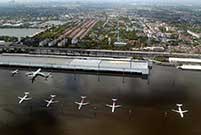

 |
| A photo shows the picture taken by a Mars rover on Mars. [Photo: huanqiu.com] With 2016 now here, US Space Agency NASA is gearing up to make a series of advancements this year in its plans to send humans on a mission to Mars. |
At the Marshall Space Flight Center in Alabama, engineers and scientists are working out how to make the Mars mission a reality.
Paul Gilbert, manager of the science programs office at the Center, says they're still in the very early stages of working out how to get to the red planet.
"Part of that is working with our partners from the International Space Station. We're working through that organization, having discussions, what's their ideas, here are some of our ideas. And so, we're in the early sketchpad phases of trying to work that out and the partners have ideas and desires and things they want to do in cislunar space."
Teams at the Marshall Space Flight Center are taking ideas from concept to design, developing spacecraft that will land on Mars and support life in frigid temperatures.
At the Advanced Concepts Office, aerospace engineer Tara Polsgrove is giving a presentation about designs for a Mars lander that would safely deliver humans to the surface of the planet.
A Mars lander is essentially two parts. The bottom half is the descent stage, it has the propulsion systems on it to enable that soft landing. And, on top, is the payload. So, we treat this kind of like a flatbed truck. So, any kind of payload would sit on top."
Elsewhere in the facility, designs for a spacecraft that would take humans through deep space are being tested.
NASA's David Smitherman is a specialist in space habitats and he explains what the facility contains.
"You have a utility room down on the lower level, exercise room, kind of like a basement, downstairs. Your main floor level has room for the four bedrooms for the crew."
Teams are also using simulated Martian rock and soil to advance 3-D printing that could help astronauts build structures on Mars with materials already there.
Sections of the Space Launch System, which will carry the Orion spacecraft, are being constructed across the United States.
NASA scientists and engineers are now working towards the first flight of Orion on top of the Space Launch System rocket. This test will not have humans on board.
Rocket engines are being tested and NASA expects the launch of the first version of the SLS in 2018.
The first expedition to Mars is planned for the 2030s.
 Are these the world’s scariest landing strips?
Are these the world’s scariest landing strips? In pics: Left behind children in China
In pics: Left behind children in China Eight modern day engineering marvels of China
Eight modern day engineering marvels of China Chinese beauty with sexiest bottom
Chinese beauty with sexiest bottom Charming female bodybuilders of Chengdu University
Charming female bodybuilders of Chengdu University Polish sports stars strip off for risqué calendar
Polish sports stars strip off for risqué calendar Spectacular aerial photos of the Three Gorges
Spectacular aerial photos of the Three Gorges Contestants of Mrs. Globe pose for photo in Shenzhen
Contestants of Mrs. Globe pose for photo in Shenzhen
 Bikini models attend hot pot banquet in Hefei
Bikini models attend hot pot banquet in Hefei Top 20 hottest women in the world in 2014
Top 20 hottest women in the world in 2014 Top 10 hardest languages to learn
Top 10 hardest languages to learn 10 Chinese female stars with most beautiful faces
10 Chinese female stars with most beautiful faces China’s Top 10 Unique Bridges, Highways and Roads
China’s Top 10 Unique Bridges, Highways and Roads Face of China 2015
Face of China 2015 A hard year 2015’s stories
A hard year 2015’s stories Smartphone makers jockey for dominance of Chinese market
Smartphone makers jockey for dominance of Chinese market Film star's posts stirs debates on Chinese, foreign medical services
Film star's posts stirs debates on Chinese, foreign medical servicesDay|Week